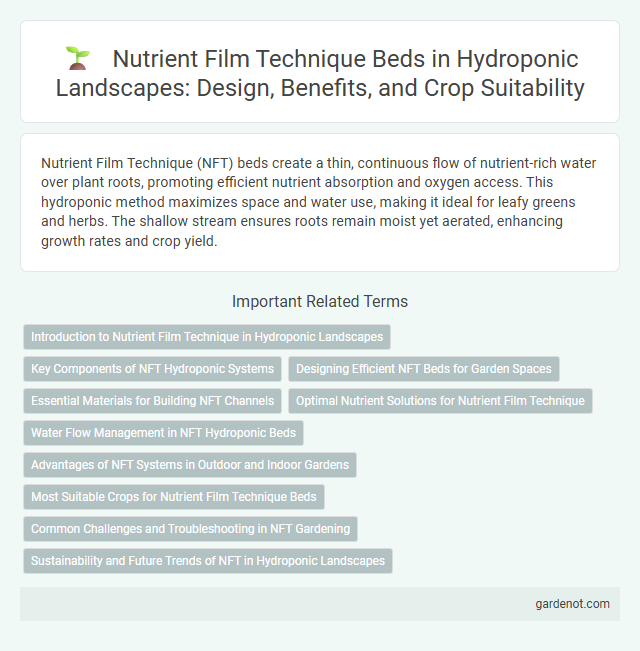Nutrient Film Technique (NFT) beds create a thin, continuous flow of nutrient-rich water over plant roots, promoting efficient nutrient absorption and oxygen access. This hydroponic method maximizes space and water use, making it ideal for leafy greens and herbs. The shallow stream ensures roots remain moist yet aerated, enhancing growth rates and crop yield.
Introduction to Nutrient Film Technique in Hydroponic Landscapes
Nutrient Film Technique (NFT) beds in hydroponic landscapes utilize a thin, continuous flow of nutrient-rich water over plant roots, optimizing oxygen and nutrient uptake. This method minimizes water usage while promoting faster growth and higher yields by maintaining consistent nutrient availability. NFT systems are highly efficient for leafy greens and herbs, supporting sustainable urban agriculture with reduced environmental impact.
Key Components of NFT Hydroponic Systems
Nutrient Film Technique (NFT) hydroponic systems rely on a shallow stream of nutrient-rich water flowing continuously over plant roots in a slightly sloped channel or bed. Key components include the NFT channels or beds, a nutrient reservoir, a submersible pump to circulate the solution, and a return system that recycles excess nutrients back to the reservoir. Effective oxygenation and proper channel design ensure optimal root exposure to air and nutrients, promoting healthy, rapid plant growth in hydroponic landscapes.
Designing Efficient NFT Beds for Garden Spaces
Designing efficient Nutrient Film Technique (NFT) beds for garden spaces involves optimizing channel length, slope, and flow rate to ensure uniform nutrient distribution and oxygenation to plant roots. Selecting materials with high durability and easy maintenance, such as food-grade PVC or HDPE, enhances system longevity and hygiene. Incorporating modular designs allows scalability and flexibility in hydroponic setups, maximizing space utilization and crop yield in compact garden environments.
Essential Materials for Building NFT Channels
Essential materials for building Nutrient Film Technique (NFT) channels include food-grade PVC or HDPE pipes, which provide a durable and non-toxic structure for water flow. A slight slope in these channels ensures continuous nutrient solution circulation over plant roots, supported by waterproof end caps and mesh net pots for stability. The system also requires fittings such as elbows and connectors to customize channel layout, maintaining efficient nutrient delivery and optimal root aeration.
Optimal Nutrient Solutions for Nutrient Film Technique
Optimal nutrient solutions for Nutrient Film Technique (NFT) beds balance essential macro and micronutrients to promote rapid plant growth and maximize yield. Maintaining a stable pH range of 5.5 to 6.5 ensures nutrient availability, while electrical conductivity (EC) levels between 1.2 to 2.0 dS/m optimize nutrient uptake without causing root damage. Tailoring nutrient concentrations based on crop type, growth stage, and water temperature enhances efficiency in this hydroponic landscape system.
Water Flow Management in NFT Hydroponic Beds
Water flow management in Nutrient Film Technique (NFT) hydroponic beds is critical for maintaining optimal nutrient delivery and oxygenation to plant roots. Precise control of water velocity ensures a thin, continuous nutrient film, preventing root suffocation and promoting efficient absorption of essential minerals. Implementing adjustable flow rates and monitoring systems enhances plant growth uniformity and minimizes risks of stagnation or nutrient imbalances.
Advantages of NFT Systems in Outdoor and Indoor Gardens
Nutrient Film Technique (NFT) systems offer efficient water and nutrient delivery by continuously circulating a thin film of nutrient solution over plant roots, enhancing oxygen uptake and nutrient absorption. Their compact design allows for space-saving installations in both outdoor and indoor gardens, maximizing crop yield per square foot. NFT systems reduce water usage by recycling nutrients, promoting sustainable gardening practices while providing precise control over growing conditions for optimal plant health.
Most Suitable Crops for Nutrient Film Technique Beds
Lettuce, spinach, and herbs such as basil and mint are among the most suitable crops for Nutrient Film Technique (NFT) beds due to their shallow root systems and fast growth cycles. Tomatoes and strawberries can also thrive in NFT systems when provided with precise nutrient management and optimal environmental conditions. Leafy greens and small fruiting plants benefit from the continuous nutrient flow and oxygen availability characteristic of NFT beds, promoting efficient growth and high yields.
Common Challenges and Troubleshooting in NFT Gardening
Nutrient Film Technique (NFT) beds often face common challenges such as root clogging, uneven nutrient flow, and pH fluctuations that can inhibit optimal plant growth. Troubleshooting involves regularly cleaning channels to prevent biofilm buildup, ensuring consistent pump operation for uniform nutrient distribution, and closely monitoring pH levels between 5.5 and 6.5 for nutrient availability. Addressing these issues promptly enhances root oxygenation and maximizes crop yields in hydroponic NFT gardening systems.
Sustainability and Future Trends of NFT in Hydroponic Landscapes
Nutrient Film Technique (NFT) beds in hydroponic landscapes promote sustainability by minimizing water and nutrient waste through continuous nutrient solution recycling, reducing overall environmental impact. Future trends in NFT include integration with renewable energy sources and smart sensors for precise nutrient delivery, enhancing resource efficiency and crop yield. Advances in biodegradable materials for NFT systems also support eco-friendly practices, aligning with the growing demand for sustainable urban agriculture.
Nutrient film technique bed Infographic

 gardenot.com
gardenot.com